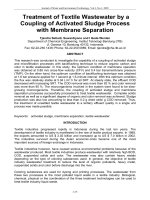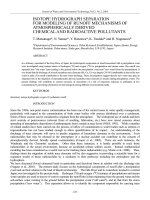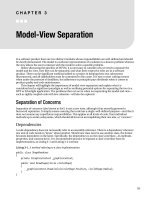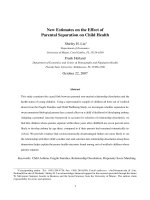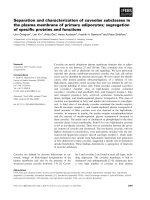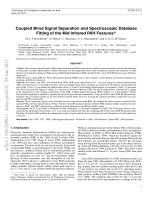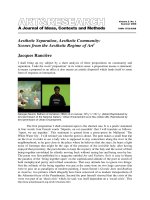Model-View Separation
Bạn đang xem bản rút gọn của tài liệu. Xem và tải ngay bản đầy đủ của tài liệu tại đây (730.78 KB, 26 trang )
C H A P T E R 3
■ ■ ■
55
Model-View Separation
In a software product there are two distinct modules whose responsibilities are well-defined and should
be clearly demarcated. The model is a software representation of a solution to a known problem whereas
the view allows the user to interact with the model to solve a specific problem.
Before discussing the specifics of MVVM, it is necessary to consider why we need to separate the
model and the view, how they can be separated, and what their respective roles are in a software
product. There can be significant workload added to a project in keeping these two subsystems
disconnected, and all stakeholders must be committed to the cause. It is easy to start cutting corners
when under the pressure of deadlines, but adherence to principles pays dividends when it comes to
product quality and code maintenance.
This chapter will highlight the importance of model-view separation and explain why it is
considered such a significant paradigm as well as outlining potential options for separating the two in a
WPF or Silverlight application. The problems that can occur when not separating the model and view—
such as tightly coupled code with low cohesion—will also be explored.
Separation of Concerns
Separation of concerns (also known as SoC) is not a new term, although it has recently garnered a
buzzword reputation. It simply means ensuring that code has a single, well-defined purpose—and that it
does not assume any superfluous responsibilities. This applies at all levels of code, from individual
methods up to entire subsystems, which should all focus on accomplishing their one aim, or “concern.”
Dependencies
A code dependency does not necessarily refer to an assembly reference. There is a dependency wherever
one unit of code needs to “know” about another. Should one class need to use another class, the former
becomes dependent on the latter. Specifically, the dependency is on the class’s interface—its methods,
properties, and constructor(s). It is recommended practice to separate a class’s interface from its
implementation, as Listing 3–1 and Listing 3–2 contrast.
Listing 3–1. A method referring to a class implementation
public class ShapeRenderer
{
private IGraphicsContext _graphicsContext;
public void DrawShape(Circle circleShape)
{
_graphicsContext.DrawCircle(circleShape.Position, circleShape.Radius);
}
}
CHAPTER 3
■
MODEL-VIEW SEPARATION
56
Listing 3–2.
A method referring to an interface
public class ShapeRenderer
{
private IGraphicsContext graphicsContext;
public void DrawShape(IShape shape)
{
shape.Draw(graphicsContext);
}
}
It is worth noting that both listings have the same intent—to draw a shape. Let’s take a moment to
consider the differences between the two listings and the implications of both options.
With Listing 3–1, the only shape that is accepted is a
Circle
. In order to support alternative shapes,
the method must be overloaded to accept each additional shape type as a parameter. Each time a new
shape is added, the
DrawShape
code must also be changed, increasing the maintenance burden. The
Circle
class, plus any additional shapes, must also be visible at compile time to this code. Finally, the
DrawShape
method knows too much about the implementation of the
Circle
class. Granted, in this brief
example, it is reasonable to assume that
Circles
would have
Position
and
Radius
properties. However,
they are publically readable by anyone, and this unnecessarily breaks encapsulation.
The data that the
Circle
object contains should not be revealed to third parties, if possible. Perhaps,
in future iterations, the
Position
property is split into its constituent
X
and
Y
components—this code
would subsequently fail to compile due to such a breaking change. Encapsulation is intended to protect
client code from interface changes such as this.
Listing 3–2 corrects a number of problems with the original code by using various techniques to
achieve a separation of concerns. The
DrawShape
method now accepts an interface,
IShape
, rather than a
single concrete implementation of a shape. Any class that implements the
IShape
interface can be
passed into this method without any changes to the method at all.
Another technique is then used to preserve encapsulation of each shape: inversion of control (also
known as IoC). Rather than querying the shape’s members in order to draw the shape, the method
instead asks the shape to draw itself. It then uses Dependency Injection (DI) to pass the shape the
IGraphicsContext
interface that it requires to draw itself. From a maintenance point of view, this
implementation is much more extensible. Adding a new shape is easy—merely implement the
IShape
interface and write its
Draw(IGraphicsContext)
method. It is important to note that there are no changes
required to the
DrawShape
method or its class whenever a new shape is introduced.
Of course, there is an obvious drawback to the code in Listing 3–2. It is more complex and less
intuitive than the code in Listing 3–1. However, these problems are not insurmountable—given time, the
latter can become more intuitive than the former.
A key objective in SoC is to limit dependencies as far as is possible and, where a dependency must
exist, abstract it away so that the client code is protected from changes. Code that is too interdependent
is hard to maintain because a single change can break innumerable parts. The worst kind of code
dependency is a cyclic dependency, whereby two methods, or two classes, are mutually dependent on
each other.
In order to solve the problem of cyclic dependencies, we must ensure that dependencies are
properly directed. In other words, that the code forms a hierarchy from bottom to top, with code at
higher levels dependent on code at lower levels. Figure 3–1 illustrates this using the M
VVM architecture
used in this book.
k
CHAPTER 3 ■ MODEL-VIEW SEPARATION
57
Figure 3–1. MVVM layers with arrows depicting the dependency direction
The view has no knowledge of the model. Instead, it acquires everything it needs from the
ViewModel. In turn, the ViewModel acquires everything it needs from the model, decorating the data
and operations with interfaces that the view can understand and utilize. Changes in the view are entirely
irrelevant to the model, which has no concept of the existence of the view. Changes in the model are
mitigated by the ViewModel, which the view uses exclusively. Ideally, the view assembly will not even
include a reference to the model assembly, such is the separation afforded by the ViewModel.
Partitioning Dependencies with Assemblies
Assemblies form natural boundaries around code. They neatly encapsulate a subsystem of interrelated
classes and are easily reused. While it is viable to use a single assembly for an application, this can lead
to a confusing mixture of code types. In a WPF or Silverlight application, mixing XAML files with code
(.cs or .vb) files is indicative of an underlying structural problem.
It is often more advisable to split the functionality of an application into more manageable pieces
and decide where the dependencies occur. In order to replicate the MVVM layers in Figure 3–1, start up
Visual Studio 2010 and create a new solution with a WPF application or Silverlight application as the
project type. Then add two class libraries: one called Model and one called ViewModel. The result
should look something like Figure 3–2 in Solution Explorer.
CHAPTER 3 ■ MODEL-VIEW SEPARATION
58
Figure 3–2. The Model, View, and ViewModel assemblies in Solution Explorer
As you can see, these are default assemblies, and the View project is set as the start-up project; the
entry point to the application. However, the assemblies currently do not reference each other. Right-
click on the View project and select “Add Reference…” to select the ViewModel project, as shown in
Figure 3–3.
Figure 3–3. Adding the ViewModel as a dependency of the View
CHAPTER 3 ■ MODEL-VIEW SEPARATION
59
Once the ViewModel has been set as a dependency of the View, go ahead and repeat the process
with the ViewModel project—this time setting the Model project as the dependency—as shown in Figure
3–4. Effectively, the three projects are in a chain with the View at the top, the Model at the bottom, and
the ViewModel in between.
Figure 3–4. Adding the Model as a dependency of the ViewModel
In a general sense, the model is not dependent on either the view or the ViewModel. It sits alone and
is isolated from them both, as models should be. The ViewModel depends on the model but not the
view, and the view depends on the ViewModel and not the model. This is a typical starting point for most
MVVM applications.
It is not entirely necessary to split the three component parts into their own assemblies, but it
makes sense to do this most of the time. The three can happily coexist in the one assembly—there are no
technical reasons why this would not work. The problem comes with human fallibility. Even with the
best intentions, the fact that the view will be able to access the model classes is likely to lead to
shortcutting past the ViewModel at some point. The term middleman generally has a negative
connotation, but not in this case. The ViewModel is a middleman that should not be bypassed.
MVVM Alternatives
Smaller software products, such as trivial in-house tools or proof-of-concept prototypes, rarely require a
framework in order to be functional, and the development effort required to set up MVVM can be a drain
on time better spent solving the real problems. Thus, it is sometimes useful to develop to another style,
using just code behind of XAML documents or a more trivial separation of model and view. Of course,
these options are for smaller projects, and they both have their significant drawbacks. MVVM may be
better suited to your particular needs.
CHAPTER 3 ■ MODEL-VIEW SEPARATION
60
■ Tip You may wish to develop a simple prototype using one of the two methods outlined here and then refactor it
to a full MVVM architecture later. This can be especially useful when trying to persuade management that WPF
and/or Silverlight are mature enough for production code—some companies believe change is expensive!
XAML Code Behind
Figure 3–5 displays the view uniting the XAML markup and the application code into one assembly. This
is the simplest and quickest solution, but it is not suitable for anything other than the most trivial of
applications.
Figure 3–5. The view amalgamates the XAML markup and the application code into one assembly
Each XAML Window, Page, or UserControl has its own code-behind file, which can be used to hook
into the click events of buttons and so forth. In these event handlers, you can do any heavy-lifting that is
applicable to the program, such as connecting to databases, writing to files, and performing financial
calculations. There is nothing wrong with this design, up to a point. Identifying the juncture where
something more scalable and robust is required is an art intended for the pragmatic programmer. When
introducing a new feature proves more difficult than it really should be, or there are numerous bugs
introduced due to a lack of code clarity, it is likely time to switch to an alternative design.
Figure 3–6 shows a screenshot from a very simple application that takes as input a port number
from the user and, when the Check Port button is clicked, displays a message box informing the user
whether the port is open or closed.
Figure 3–6. A trivial application to check whether a port on the local machine is open
It is so simple that it took about 10 minutes to write—it would have taken at least twice that if an
MVVM architecture was used. Listing 3–3 shows the XAML code, and Listing 3–4 shows its
corresponding code-behind file.
CHAPTER 3 ■ MODEL-VIEW SEPARATION
61
Listing 3–3. XAML that Constructs the Port Checker User Interface
<Window x:Class="ProWpfAndSilverlightMVVM.MainWindow"
xmlns="
xmlns:x="
Title="Port Checker" Height="100" Width="200">
<StackPanel Orientation="Vertical">
<StackPanel Orientation="Horizontal">
<Label Content="Port Number:" />
<TextBox Name="portNumber" Width="95" />
</StackPanel>
<Button Content="Check Port" Click="CheckPortClick" />
</StackPanel>
</Window>
Listing 3–4. The Code Behind that Responds to the Check Port Button
using System.Net.Sockets;
…
public partial class MainWindow : Window
{
public MainWindow()
{
InitializeComponent();
}
private void CheckPortClick(object sender, RoutedEventArgs e)
{
int portNumberInt = -1;
if (int.TryParse(portNumber.Text, out portNumberInt))
{
Socket sock = new Socket(AddressFamily.InterNetwork, SocketType.Stream,
ProtocolType.Tcp);
try
{
sock.Connect(System.Net.Dns.GetHostName(), portNumberInt);
if (sock.Connected)
{
MessageBox.Show("This port is closed :(");
}
}
catch (SocketException ex)
{
if (ex.SocketErrorCode == SocketError.ConnectionRefused)
{
MessageBox.Show("This port is open =D");
}
}
finally
{
sock.Close();
}
}
CHAPTER 3 ■ MODEL-VIEW SEPARATION
62
else
{
// invalid port number entered
MessageBox.Show("Sorry, the port number entered is not valid.");
}
}
}
This code is already a little bit muddled, but it is acceptable as long as the application is fairly static
and does not require many future features. If someone requested that it accepts a hostname or IP
address, as well as a port, so that remote ports could be queried, perhaps that would be the limit of this
code’s utility.
If someone requested that it list all of the open ports on a machine, I would be tempted to move to
the next stage, which is a separate model and view.
Model View
If the work required in the model is more involved than updating a database row or displaying the result
of a simple mathematical equation, you may wish to decouple the model from the view but omit the
ViewModel. The model will then perform two tasks in one: both model and ViewModel. Figure 3–7
shows the view and model split into two assemblies.
Figure 3–7. The view and model are split into two assemblies
Rather than having the purity of a model, which only solves the software problem at hand, the
model realizes that it is to be consumed by a WPF or Silverlight view, and includes specific ViewModel
code: commands, bindable properties and collections, validation, and so forth.
CHAPTER 3 ■ MODEL-VIEW SEPARATION
63
This architecture is actually quite scalable and will suffice for many in-house tools and prototypes.
Its main problem is the confusion between model and ViewModel, which will naturally introduce
problems as the code is trying to serve two purposes at once.
Let’s take the Port Checker example and extend it to list all of the open ports on a given machine but
use a separate model and view to achieve this goal.
The application takes as input a machine name or an IP address. In Figure 3–8, the IP address of the
localhost has been entered and the Check Ports button has been clicked.
Figure 3–8. Extended Port Checker application, which checks the state of multiple ports
The DataGrid shown lists a port number and the port’s status in a CheckBox. The port’s status is a
three-state value: open (checked), closed (unchecked), and indeterminate (filled). We will see how the
model provides this value later. As you can see, port 80 is currently closed on my machine—which
makes sense as I have a web server bound to that port.
Listing 3–5 displays the XAML code for this window. There is nothing particularly remarkable about
this code; it is fairly self-explanatory. It is sufficient to note that the “Is Open?” column is bound only one
way because this field is read-only. We cannot uncheck a port to close it or check a port to open it.
Listing 3–5. XAML Code for the Port Checker
<Window x:Class="PortChecker.View.MainWindow"
xmlns="
xmlns:x="
Title="Port Checker" Height="350" Width="525">
<DockPanel>
<StackPanel Orientation="Horizontal" DockPanel.Dock="Top">
<Label Content="Machine Name / IP Address:" />
<TextBox Width="200" Name="machineNameOrIpAddress" />
<Button Content="Check Ports" Click="CheckPortsClick" />
</StackPanel>
<DataGrid Name="ports" AutoGenerateColumns="False">
<DataGrid.Columns>
<DataGridTextColumn Header="Port Number" Binding="{Binding Number}" />
<DataGridCheckBoxColumn Header="Is Open?" Binding="{Binding Mode=OneWay,
Path=IsOpen}" IsReadOnly="True" IsThreeState="True" />
</DataGrid.Columns>
CHAPTER 3 ■ MODEL-VIEW SEPARATION
64
</DataGrid>
</DockPanel>
</Window>
The code behind this XAML file is very simple indeed. In fact, it is boiled down to just a single
method—the click handler for the Check Ports button. Listing 3–6 shows that it is very simple in
comparison to the previous Port Checker’s code behind, despite the application becoming significantly
more complex.
Listing 3–6. The Code Behind for the Check Ports Button’s Click Event Handler
private void CheckPortsClick(object sender, RoutedEventArgs e)
{
PortChecker.Model.PortChecker portChecker = new PortChecker.Model.PortChecker();
portChecker.ScanPorts(machineNameOrIpAddress.Text);
ports.ItemsSource = portChecker.Ports;
}
So, the button handler merely:
• constructs a PortChecker object
• requests that the PortChecker scans the ports on the machine name or IP address
that the user has entered into the text box
• sets the PortChecker object’s Ports property as the DataGrid’s ItemsSource
It is clear that the heavy-duty port-scanning code has been moved into a dedicated object: the
PortChecker, which is part of a separate PortChecker.Model namespace. Listing 3–7 shows the model
code for the PortChecker.
Listing 3–7. The Model Code for the PortChecker
using System.Collections.ObjectModel;
using System.Net;
using System.Net.Sockets;
namespace PortChecker.Model
{
public class PortChecker
{
public PortChecker()
{
Ports = new ObservableCollection<Port>();
}
public ObservableCollection<Port> Ports
{
get;
private set;
}
public void ScanPorts(string machineNameOrIPAddress)
{
